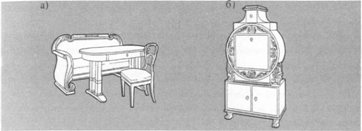
To identify the features of modern furniture, it is necessary to get acquainted with characteristic examples of creating furniture in the main periods of its development.
The most ancient models that have come down to our time are the furniture of ancient Egypt (Fig. 1). Egyptian furniture is distinguished by simplicity of shape, curved lines (legs, backs, chairs, etc.), decorative inserts of gold, colored enamel and ivory mostly with images of plants. The main furniture products in Egypt were stools - folding and on four vertical legs, chairs and paired legs in the form of lion paws and bull legs. Pharaohs' thrones were distinguished by special decorations and luxury. The backs of the thrones were covered with a through symbolic thread with a weak relief. Widely used gaskets made of precious metals with colored enamel. A special feature of the Egyptian beds were special coasters that allow you to save a complex hairstyle. Housewares and clothing were stored in brightly painted and inlaid chests and chest boxes.
The furniture used in ancient Greece (Fig. 2) in everyday life was distinguished by simplicity and convenience. It testifies to the ability to combine utilitarian beginnings with a truly artistic form, manifested by ancient Greek masters not only in architecture, but also in the artistic craft. Greek chairs usually had bent, widely spaced legs and a curved back with a wide concave web at the top. For the storage of clothes and other property, the Greeks were chests and lari, very simple in outline. They kept precious hats and small things in small boxes. The most characteristic furniture of the Greeks was the kline - a rather high bed on four massive legs, usually profiled and richly decorated with inlays.
The style of furniture of ancient Rome (Fig. 3) was strongly influenced by the culture of Greece, Eastern countries and Egypt. For the Roman furniture is characterized by a large number of ornaments, abundant ornamentation. The ornament depicted plants, people and animals. The peculiarity of the ornament was military attributes.
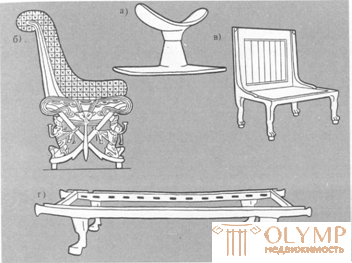
Fig. 1. Examples of furniture in ancient Egypt: a - head bench; b - the throne; in - a chair; g - bed frame
Ancient Roman furniture is divided into two main types: wooden, decorated with carvings, gilding, inlaid wood, enamel, earthenware, gold and silver; decorative fixed of white or colored marble with mosaic boards on the tables. In addition, the furniture was made of bronze and woven from wicker rods.
The main products of ancient Roman furniture were four types of chairs. For the officials of the Roman Empire - consuls and praetors were intended for curule chairs with a square seat and X-shaped legs. First kurulnye armchair made folding, then they began to provide backs. For senior officials and citizens with special merits, was designed bench with a double seat - bicellium. The high-backed chair for the head of the family was called the solium. For women, special chairs were made with a comfortable semi-circular back - catedra.
Tables were made round and rectangular. Round tables were strengthened on three legs in the form of animal paws, elegantly curved and richly decorated. The rectangular tables had solid sidewalls with deep relief carving, depicting double figures of griffins, lions, and eagles. The table covers were smooth, decorated with mosaic or stone inlay.
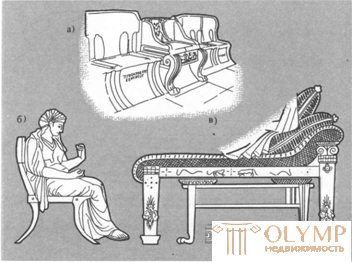
Fig. 2. An example of the furniture of ancient Greece: a - a chair in the theater; b - a chair; in - bed
Byzantine furniture is almost not preserved to this day and is known mainly from the images. She repeated the form of the furniture of Rome of the late period. It is characterized by great pomp and congestion with decorations. In a later period, the East began to influence Byzantine life. Low ottomans, sofas, pillows, carpets, silk fabrics appeared. Along with the departure from the traditions of ancient art and the fascination for luxury, the wealth of the material used for the manufacture of meben items became to prevail over the grace and beauty of its forms.
The Romanesque style (Fig. 4) prevailed in Europe until the beginning of the XIII century. The furniture used by the majority of the population in this era was simple and even primitive. The main distribution was received by rough tables, stools on three and four legs, benches. The first place among household items belonged to the chest, which was used as a table, chair, bed, and mostly as a wardrobe. Chest retained its purpose until the XVIII century. Furniture for seating (chairs, benches) was made from sets of turned cores. In addition to the usual four-legged chairs and chairs, the chiselled tripod stool was spread. The furniture was painted in bright colors.
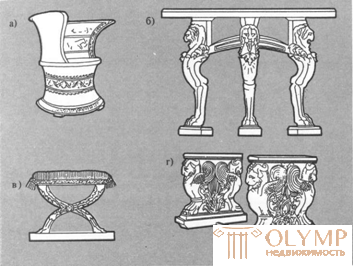
Fig. 3. Examples of furniture of the Ancient Rome: a - a chair; b - table; in g kurulny stool; g - table supports
The material for the manufacture of furniture were spruce, cedar and oak. The furniture of the Romanesque style was found in the homes of the peasants up to the 18th century, and even in the 20th century, it partially preserved its main features. With the passage of time, folk furniture somewhat eases the proportions, freeing itself from an excess stock of material.
From the XIII century, first in architecture and then in the furniture, the Gothic style was spread. The forms of furniture repeat the forms of architecture (Fig. 5) in the form of thin columns and ornaments. Appears paneled furniture with abundant carvings. The furniture business receives special development in the 15th century in northern France, in the cities of Flanders. Seats of chairs get various forms - round, rectangular, many-sided.
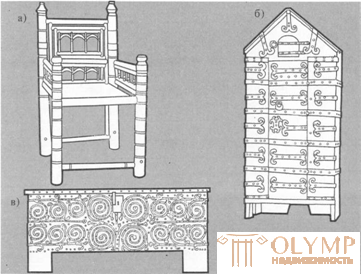
Fig. 4. Examples of furniture in the Romanesque style: a - a chair; b - wardrobe; in - chest
A typical type of Gothic armchair becomes a chest, to which a very high, deaf back with deaf elbows was attached. The seat was usually arranged lifting. Some parts of the seats, especially the corner elements, which are the basis of the design, were richly decorated. In everyday life includes postavtsy, cabinets and cupboards. The prototype of the supply cabinet on the pillars was a chest with four legs connected at the bottom with a horizontal frame. Subsequently, the lower frame was sutured tightly and the rear legs were connected with boards. The doors of the upper compartment were made regular, double or hinged '. The upper part was added to a canopy with a canopy and a canopy, treated in the form of lancet vaults. Such supplies were used to store silverware. A brilliant copper dish was placed on the bottom of the base of the open part. In the 15th century, large closed cabinets with two or four doors appeared. The canopy beds with a curtain curtain begin to spread. All furniture is usually made of oak wood. The late Gothic style is characterized by a combination of carving with painting and gilding. The gothic style of furniture is characterized by significant local differences. The greatest elegance of proportions, decorations, as well as the proportionality of the parts differed French furniture.
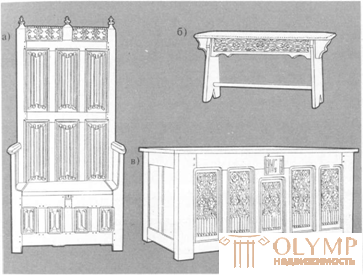
Fig. 5. Examples of furniture in the Gothic style: a - chair: b - bench; in - chest
Most of the Gothic style in furniture was common in England. At the end of the 15th century, classical details appeared on the Gothic construction, as a result of which a mixed style was formed, passing from Gothic to Renaissance and named Tudor style.
The Renaissance style that arose in the second half of the 15th century in Italy penetrates into France and Spain, and then Flanders. In the development of furniture and decorative art of the Renaissance of Italy (Fig. 6) there are two main periods: the early Renaissance (XIV-XV centuries) and the High (later) Renaissance (XVI century).
In the era of the early Renaissance, new canons were created in the fight against the Gothic forms on a classical basis. New art arises in Florence. In the era of the early Renaissance, the centers of furniture art were also Bologna, and then Siena.
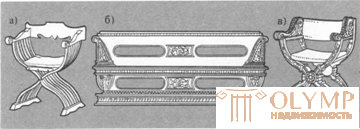
Fig. 6. Examples of furniture mioin Renaissance (Italy): a - Savonarola's chair; b - Kasapank bench; in - Dante's chair
Furniture of this period is characterized by simplicity of forms and details. In chairs and armchairs dominated by a straight line. Great importance is attached to the profiling of products, classical acanthus and other floral ornament are reviving, as well as animal images. The most common material is walnut wood. Carving, wooden inlay, as well as gilding and painting, which are often performed by outstanding craftsmen, are widely used. For example, such large artists as Sandro Botticelli and others worked on the painting of wedding chests (cassette) - the most common furniture product. Along with wedding chests, a chest-bench with backrest and massive armrests and kredenz were used - a low buffet with doors and drawers , as well as chairs with X-about-different legs. Tables are made mostly rectangular on massive supports connected by a bar. In addition to chests, chests, benches, chairs, chairs, low non-canopy beds and lecterns are used to read books. At the end of the 15th century, when architectural patterns dominate the decoration of furniture, wardrobes appear. They represent two coffers stacked on top of each other with two-floor doors, consoles, pilasters, a rich plinth and a cornice.
Furniture High Renaissance becomes richer decorated. Classical forms of furniture acquire a greater variety. Details are distributed in the form of lion paws, masks, human figures and animals. In the 16th century, a multicolored mosaic made of various wood species was used to decorate furniture, which covered not only the front, but also the inside of the cabinets.
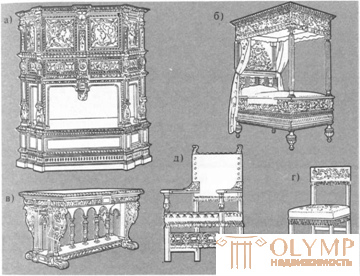
Fig. 7. Examples of Renaissance furniture (France): a - wardrobe; b - bed: c - table; g - a chair; d - chair
Chairs are made of two types: with four straight legs of square section, rear pillars, turning into a straight back, connected by two or three crossbars, ornate boards; with an octahedral seat and carved supports - boards instead of legs. The backs of the chairs and armchairs are covered with carpets, embossed leather, velvet and brocade. Seats trim fringe. Cabinets-cabinets appear, representing a cupboard on a stand made of small drawers of three or five kinds, the outer side of which is richly decorated with inlays. The set of boxes was closed with small doors, decorated with wooden stacked paintings with promising types of architectural structures.
The center of furniture production in the late Renaissance epoch from Florence moves to Rome, where richly decorated furniture is made (for example, the bureau of Pope Paul III).
In the French Renaissance (Fig. 7) in the XVI century, two periods are also distinguished: the first is attributed to the years of the reign of Francis I, the second to Henry II. The furniture of the first period is characterized by a combination of proportions close to gothic, with Italian ornament and classical profiling. The second period is the mature French Renaissance and is characterized by the proliferation in forms and ornaments of classical elements. In a later period, the carving becomes richer, with a strong relief. Typical use is instead of columns of complex carved balusters and caryatids. Significant distribution, finds coming from Italy extensor stool with massive arcs. Last quarter XV! century gives new samples of furniture, in which the abundant carving is combined with inlay and complex shaped panels.
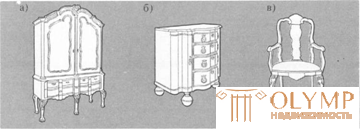
Fig. 8. Examples of baroque furniture (Holland): a - wardrobe; b - chest of drawers; in - chair
The interiors of the XVII century baroque style are subordinated to the idea of the movement of masses and space, which is achieved in the design of the walls with the help of painting and sculpture with moving lines and stucco decorations above the doors and windows, on the eaves and ceiling lamps. Furniture (consoles, benches, tables, chairs, bureau offices) corresponds to the decoration of the walls and is also richly decorated. The office cabinets use colored wooden mosaic depicting entire scenes.
The furniture is upholstered in dark velvet with large patterns. Chairs are equipped with vertical legs, curved or pyramidal shape with a pitcher-like extension at the top. The legs of the stools are often placed diagonally. The curving forms of the legs end in curls diverging in different directions. Table tops are made in hexagonal or octagonal shape, and edges are machined. various profiles, spoons and other decorations. Chests, chests and setters go out of use and are replaced by cabinets and bureau offices with carvings, inlays of colored stone mosaic, and ground colored glass.
Baroque from Italy is distributed throughout Europe. First, this style appears in Antwerp (from 1620), then penetrates into Holland (around 1630), where it acquires specific features (Fig. 8). In Germany, it develops after the end of the thirty-year war and has a strong imprint of the influence of Dutch furniture. In France, the Baroque style develops during the reign of Louis XIV. Among the prominent furniture makers of the time, a special place belongs to the Boules family (the founder of the company Andre-Charles Buhl and his sons Jean, Pierre and Karl). Often furniture of the era of Louis XIV called furniture in the style of Boule. With the relative simplicity of the form, this furniture was distinguished by a certain heaviness and an abundance of ornamentation in the form of panels, the compositions of which included flowers, ribbons, and intertwining curls.
Chairs, chairs and sofas in this era are made with high backs, ending in a semicircular top above the head sitting. Furniture for sitting upholstered with a cloth attached to the nails, and decorated with fringe on the lower hem of the seat. The legs of the chairs and armchairs are made of two types: pyramidal with profiling and in the shape of the letter S, the ends of which are decorated with edging of leaves. Sofas decide in the form of three interconnected chairs. The upholstery of such sofas is made of rich tapestry-type decorative fabric, executed in bright colors, in the ornament of which, in addition to wide ornamental divorces with large colors, images of birds and small animals are used. Decorative fabric according to special designs for backs and seats was made on the royal manufactories of Bove and Aubussons. The main furniture material was oak, walnut and ebony.
Along with cabinets, cabinets, tables, soft armchairs, chairs, sofas, consoles were widely used in interiors, which were special tables that were placed under mirrors and by the walls. The main decoration of the consoles was a carved underframe, entirely covered with gilded figured carvings.
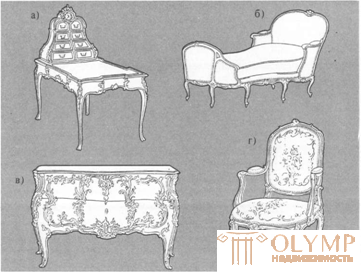
Fig. 9. Examples of furniture in the Rococo style (France): a - a desk; b - couch; in - a dresser; d - chair
At the border of the XVII and XVIII centuries in the style of Louis XIV, there is a tendency towards lightweight forms and curved lines.
The furniture of the Louis XIV style was replaced first by the furniture of the transitional period — regency, which fell on the first quarter of the 18th century, and then by the furniture in the rococo style (Fig. 9).
Furniture for the period of regency inherent in the main features of the furniture of Louis XIV style, but its shape and decoration are facilitated. Classic ornaments are replaced with light plant arabesques. The composition is solved by a free combination of straight and curved lines. The most prominent master of the regency period was Charles Kressan. He perfectly mastered the technique of inlay - marquetry and the art of chasing bronze.
In the second quarter of the 18th century, the Rococo style, also called the Louis XV style, was fully formed. The furniture of this period is small and is very comfortable. Pillows covered with silk with woven pastoral scenes are placed on the seats of chairs and sofas; ornament and flowers. Sofas are solved according to the scheme found during the Baroque period, but the middle part is made wider than the outermost ones and the legs are unevenly spaced - the middle ones are at a greater distance than the side ones. Commodes covered with lacquer and painted mainly depicting stylized Chinese landscapes appear and are widely spread. The furniture of the Rococo period is characterized by light coloring of wooden parts, gilding and a large number of bronze overlays.

Fig. 10. Examples of furniture T. Chiplendel: a - wardrobe; b - chair; and - hours; d - double sofa
Simultaneously with the Rococo era, the work of the outstanding English cabinet maker Thomas Chip-Pendel, who created a new style in furniture, is distinguished by great comfort, good proportions and exquisite forms (Fig. 10). Chippendel style originated on the basis of the Dutch style of Queen Anne, Chinese furniture art and the achievements of the Rococo period in France. Толчком к развитию нового стиля английской мебели явился привоз больших партий красного дерева, которым заменили орех, служивший до этого основным материалом для мебели. Стулья
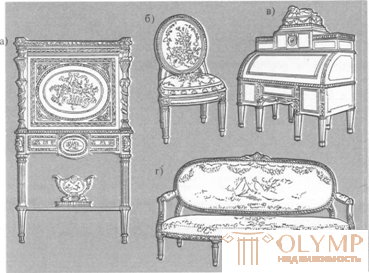
Fig. 11. Примеры мебели в стиле классицизма (Франция): а — шкаф; б — кресло; в — бюро; г — диван
Чиппенделя обладают характерным силуэтом, решетчатой спинкой, украшенной разнообразными узорами. В отличие от французской мебели, где фактура дерева скрыта позолотой или сплошной окраской, английская мебель покрывалась только воском, что позволяло видеть текстуру древесины.
Мебель Чиппенделя нашла широкое признание не только в Англии, но и в других странах благодаря изданному им в 1754 г. альбому с образцами мебели.
Господствовавший почти в течение века стиль рококо сменился в последней четверти XVIII века новым стилем — классицизмом (рис. 11), отличавшимся четкостью и строгостью линий и форм. Во Франции мебель эпохи классицизма получила название стиля Людовика XVI. Характерным признаком классицизма в мебели является ясно выраженная конструкция. Вертикальные опоры и горизонтальные элементы ясно видны, тогда как в мебели стиля рококо места соединений частей всегда были замаскированы резьбой, бронзовыми накладками создававшими впечатление цельного пластичного объема. На формирование стиля классицизма большое влияние оказали открытия в Помпее, а также изучение античного искусства.
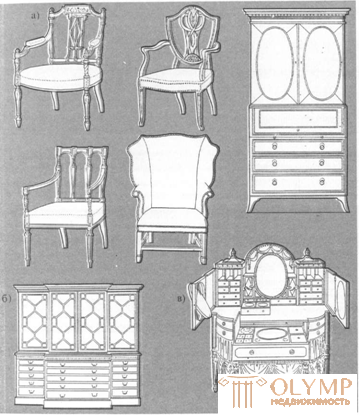
Fig. 12. Примеры мебели Хепплуайта и Шератона: а — кресла: б — шкафы; в — туалетный стол
Комоды, письменные столы, бюро, секретеры снабжаются ровными прямолинейными карнизами и тягами. Для украшения центральных филенок или панно вставляют небольшие барельефы из золоченой бронзы в виде медальонов, подвешенных на широких лентах. Для облицовывания применяют в основном красное дерево, украшенное маркетри. Употребляют также привозную древесину, атласное, тюльпанное, розовое, гиацинтовое и лимонное дерево.
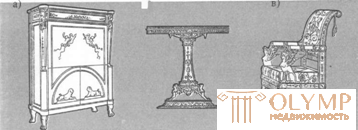
Fig. 13. Примеры мебели в стиле ампир (Франция): а — шкаф; б — стол; в — кресло
Деревянная мозаика на плоских элементах мебели состояла из небольших ромбов или кубиков с тонкой контурной прокладкой более темного цвета между орнаментом. Для контуров употреблялись темные породы древесины: туя, палисандровое и черное (эбеновое) дерево. Для обивки мебели продолжают применять штучные ткани, исполненные на мануфактурах гобеленов и Бовэ, а также вышивка (букеты полевых цветов, сцены из пастушеской жизни), шелковые ткани с вертикальными линиями, перевитыми гирляндами или букетами мелких цветов. Наиболее известными мастерами в эту эпоху были Ризнер, Бенеман.
In England at the end of the 18th century, Chipdendel was replaced by Hep-Pluite and Sheraton - masters of classicism (Fig. 12), whose furniture, especially Sheraton, is distinguished by clear forms, complete absence of curved lines and great care in drawing and processing details. A characteristic feature of the skill of Sheraton was a skillful selection of wood of different colors.
In the last quarter of the 17th century, combined furniture appeared in England: office cabinets connected with porcelain slides, drawers with folding writing boards connected with bookcases.
The French Revolution (1789-1794) changed the tastes of the new bourgeoisie and caused the appearance of the style of the directory (1795-1799), and then the consulate (1799-1804) and the Empire style. In the directory period, furniture of a more strict and classical form appears. Antique details are becoming popular in the form of ancient Roman armature: shields, helmets, copies and other elements of the antique ornament. At the consulate, the curved lines are straightened and get clarity and dryness. Directory styles and consulates were transitional from the style of Louis XVI to the Empire.
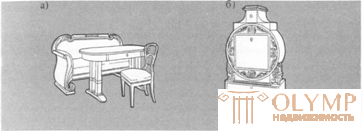
Fig. 14. Examples of furniture s style 6i-dermayer: a - for the living room; b - secretary
The founder of the Empire style (Fig. 13) is considered to be the artist David, and his expressions are the architects Charles Persier and Pierre Fontaine. The furniture according to their designs was carried out by furniture master Jacob, who was famous at the time. Characteristic features of the Empire style were the transfer of antique, especially Roman architectural forms (columns, pilasters, consoles, cornices and friezes) to furniture for dividing the front sides of cabinets and chest of drawers. The supporting parts of tables, chairs, chairs, sofas were made in the form of antique germs, sphinxes, griffins, columns and lion legs. The forms of furniture were rectangular, massive, closed. An important role was played by the texture of the material, which was previously hidden behind a mass of carved ornaments and various templates. The most common material was dark mahogany, decorated with bronze, gilded through fire, with strictly symmetrical patterns. They upholstered furniture with blue, yellow, terracotta cloth and silk, on the background of which stars and rosettes were scattered in staggered fashion. Seating furniture is sometimes leather covered.
The forms of Empire style furniture were influenced not only by the excavations in Pompeii, but also by the art of Egypt, which the French got acquainted with during the Napoleonic African campaigns.
Biedermeier-style furniture came to replace empire furniture (Fig. 14). Made in London, Vienna, Berlin For the bourgeois strata of society, it is more intimate, comfortable compared to the furniture in the Empire style. Clear tectonic divisions, columns and pilasters were abolished, sharp outlines of profiles and corners were rounded, soft curves of the backs of chairs, chairs and sofas were introduced. Instead of silk upholstery, chintz and rep are used, soft backs and seats are made of horsehair. In an effort to give home comfort, prefer sofas and sofas. In furniture products use few decorations. Furniture is usually veneered with smooth plywood of beautiful texture. In addition to mahogany plywood, they use light birch, ash, pear and cherry wood.
In the 20s of the 19th century, Gothic elements appeared in connection with the passion for romance in the decoration of furniture, and in the 1930s furniture imitating Oriental styles was distributed.
After the victory of the bourgeoisie in the French revolution of 1848, tastes change. The wealthy bankers, industrialists and traders seeking luxury, are addicted to eclecticism — a mixture of modern style with revived old forms. All sorts of decorations appear, a strong rococo style is felt, and velvet and plush upholstery with fringe are used instead of chintz and reps. Eclecticism was alien to the true spirit of the style, which imitated, and the needs of modernity. Aesthetic promiscuity and pretentiousness are especially characteristic of the furniture of the second empire of Napoleon III.
Even a brief examination of the centuries-old history of furniture makes it possible to note that the shaping of furniture products occurs under the influence of a number of factors, which include: socio-economic structure; way of life of a particular layer or class of society; architectural features and level of housing construction; the nature of the manufacture of furniture and the materials used; local characteristics and traditions; leading art movements.
Что бы оставить комментарий войдите
Комментарии (0)